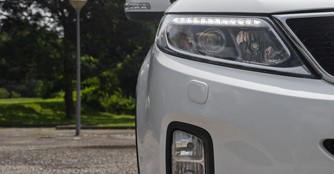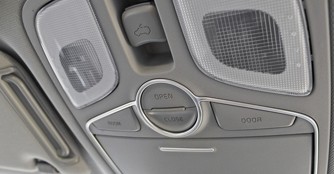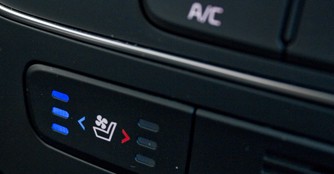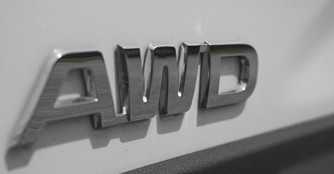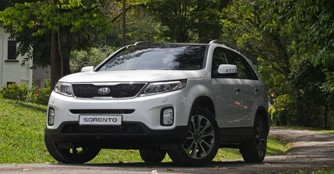Kia Sorento Diesel 2.2 CRDi (A) Review
23 Jan 2013|34,377 views
The Sorento nameplate has been around since 2002. The first generation Kia Sorento was a traditional truck-based (body-on-frame) SUV. It was a very capable off-roader, with an automatic four-wheel drive system featuring low range gearing.
In 2009, a redesigned second-generation Kia Sorento was launched, sporting Kia's new corporate grille, known as the 'Tiger Nose', as designed by then Design Chief, Peter Schreyer, who has since been appointed the group's CEO.
Two years later, the 2011 model was introduced. No longer based on a truck frame, the new Sorento was of monocoque construction.
A refreshed Kia Sorento then made its debut at the 2012 Los Angeles Auto Show and was given a slight facelift. More notably, it received changes to its powertrain, including a new 2.2-litre CRDi engine and a 2.4-litre GDi engine, which has been introduced here in Singapore.
The Sorento is also the first Kia passenger car on our shores to be available in a diesel engine.
Exterior
On first glance, one can immediately notice the newly designed headlights with HID Xenon as standard. These headlights are embedded with Adaptive Front Lighting system which point in the same direction the vehicle is travelling in, thus improving driver visibility.
In 2009, a redesigned second-generation Kia Sorento was launched, sporting Kia's new corporate grille, known as the 'Tiger Nose', as designed by then Design Chief, Peter Schreyer, who has since been appointed the group's CEO.
Two years later, the 2011 model was introduced. No longer based on a truck frame, the new Sorento was of monocoque construction.
A refreshed Kia Sorento then made its debut at the 2012 Los Angeles Auto Show and was given a slight facelift. More notably, it received changes to its powertrain, including a new 2.2-litre CRDi engine and a 2.4-litre GDi engine, which has been introduced here in Singapore.
The Sorento is also the first Kia passenger car on our shores to be available in a diesel engine.
Exterior
On first glance, one can immediately notice the newly designed headlights with HID Xenon as standard. These headlights are embedded with Adaptive Front Lighting system which point in the same direction the vehicle is travelling in, thus improving driver visibility.
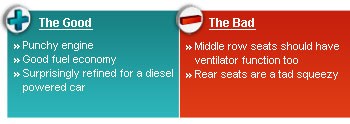 |
LED daytime running lights also come as standard and instead of having the 'eyeliner' position, they now sit on the 'eye shadow' position.
There are also brand new vertical fog lights that replace the old rounded ones. Amplifying side illumination, these Cornering Fog Lamps help to improve overall visibility.
Also sporting a new design is the front grille mesh together with a new front bumper that enhance the already commanding stance of the car.
At the rear, changes can be easily spotted too. Kia's designers went for a new tailgate design in order to give the appearance of greater width. This is further magnified thanks to new combination tail lights and a decidedly sportier bumper.
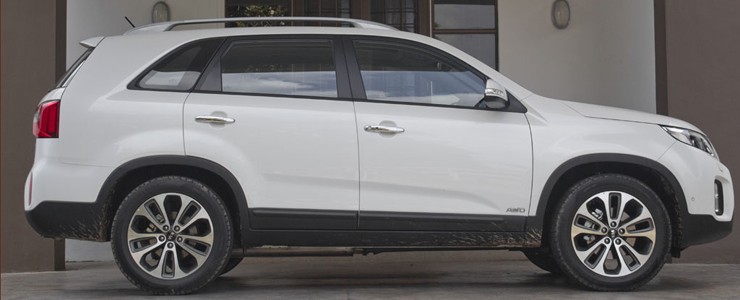 |
Interior
The interior styling of the Sorento is modern and functional but a fair bit of hard plastics can be found in most areas. Nonetheless, one cannot deny the leap of improvement this car has over its predecessor, considering the new and exciting features the car boasts.
Compared to the outgoing model, the Sorento features a new digitalised instrument panel providing useful driving information in the clearest way possible.
Thanks to a reduction in size of the centre roof steel bar, the panoramic sunroof is now slightly wider. Together with a power rolling blind which was missing in its predecessor, they provide a spacious and airy ambience in the cabin at the convenience of a button.
The car we tested came with duo tone black and white seats and they proved comfortable and supportive, which is a plus on longer journeys.
The interior styling of the Sorento is modern and functional but a fair bit of hard plastics can be found in most areas. Nonetheless, one cannot deny the leap of improvement this car has over its predecessor, considering the new and exciting features the car boasts.
Compared to the outgoing model, the Sorento features a new digitalised instrument panel providing useful driving information in the clearest way possible.
Thanks to a reduction in size of the centre roof steel bar, the panoramic sunroof is now slightly wider. Together with a power rolling blind which was missing in its predecessor, they provide a spacious and airy ambience in the cabin at the convenience of a button.
The car we tested came with duo tone black and white seats and they proved comfortable and supportive, which is a plus on longer journeys.
Based on European specifications, both driver and front passenger seats sport a heater (though not often used here) as well as a ventilator function that keeps them cool in the tropical heat.
Middle row seats are just as comfy, with adequate head and legroom. However, unlike some of its peers, the position cannot be adjusted, limiting seating flexibility.
Third row seats are best left for kids or pint-sized adults without much discomfort on short trips. But when not in used, these seats fold down as flat as a pancake, increasing the boot space by a couple of notches, transforming the look of a stylish MPV into that of a spacious SUV.
Middle row seats are just as comfy, with adequate head and legroom. However, unlike some of its peers, the position cannot be adjusted, limiting seating flexibility.
Third row seats are best left for kids or pint-sized adults without much discomfort on short trips. But when not in used, these seats fold down as flat as a pancake, increasing the boot space by a couple of notches, transforming the look of a stylish MPV into that of a spacious SUV.
 |
The Drive
The new 2.2-litre CRDi diesel powerplant under the Sorento Diesel's hood provides for 194bhp and 436Nm of torque to all four wheels, allowing the car to go from 0 to 100km/h in just 9.9 seconds.
Slight diesel clatter is noticeable when stationary, but once its warmed up, the engine is quiet, making it a good companion, especially when cruising on the expressway.
Fuel consumption is also impressive. We were able to obtain an average fuel economy of 8.3km/L without frugal driving or the Active ECO mode switched on.
This seven-seater SUV has a sporty feel on urban roads and yet is comfortable and stable off road, credits going to a four-wheel drive lock mode which also comes standard.
More notably, steering the Sorento is now customisable, thanks to a new feature known as the 'Flex Steer' system.
The new 2.2-litre CRDi diesel powerplant under the Sorento Diesel's hood provides for 194bhp and 436Nm of torque to all four wheels, allowing the car to go from 0 to 100km/h in just 9.9 seconds.
Slight diesel clatter is noticeable when stationary, but once its warmed up, the engine is quiet, making it a good companion, especially when cruising on the expressway.
Fuel consumption is also impressive. We were able to obtain an average fuel economy of 8.3km/L without frugal driving or the Active ECO mode switched on.
This seven-seater SUV has a sporty feel on urban roads and yet is comfortable and stable off road, credits going to a four-wheel drive lock mode which also comes standard.
More notably, steering the Sorento is now customisable, thanks to a new feature known as the 'Flex Steer' system.
This allows you to toggle your preferred steering modes between Normal, Comfort and Sport, with the latter being the most communicative and having the heaviest feel. Normal and Comfort modes are seemingly indifferent in our opinion.
The Sorento is also the first Kia to sport the Smart Parking Assist System. Currently only assisting in parallel parking, we reckon it'll be no surprise that vertical parking assist will most probably come into place in the near future - all done in order to keep up with technological trends.
Conclusion
You can easily place that adventurous self in a Sorento or just simply bringing the family out for a leisurely ride. The car has great performance and economy, looks the business and is generously equipped.
With the new Sorento, Kia has already set its sights on the premium SUV segment.
The Sorento is also the first Kia to sport the Smart Parking Assist System. Currently only assisting in parallel parking, we reckon it'll be no surprise that vertical parking assist will most probably come into place in the near future - all done in order to keep up with technological trends.
Conclusion
You can easily place that adventurous self in a Sorento or just simply bringing the family out for a leisurely ride. The car has great performance and economy, looks the business and is generously equipped.
With the new Sorento, Kia has already set its sights on the premium SUV segment.
The Sorento nameplate has been around since 2002. The first generation Kia Sorento was a traditional truck-based (body-on-frame) SUV. It was a very capable off-roader, with an automatic four-wheel drive system featuring low range gearing.
In 2009, a redesigned second-generation Kia Sorento was launched, sporting Kia's new corporate grille, known as the 'Tiger Nose', as designed by then Design Chief, Peter Schreyer, who has since been appointed the group's CEO.
Two years later, the 2011 model was introduced. No longer based on a truck frame, the new Sorento was of monocoque construction.
A refreshed Kia Sorento then made its debut at the 2012 Los Angeles Auto Show and was given a slight facelift. More notably, it received changes to its powertrain, including a new 2.2-litre CRDi engine and a 2.4-litre GDi engine, which has been introduced here in Singapore.
The Sorento is also the first Kia passenger car on our shores to be available in a diesel engine.
Exterior
On first glance, one can immediately notice the newly designed headlights with HID Xenon as standard. These headlights are embedded with Adaptive Front Lighting system which point in the same direction the vehicle is travelling in, thus improving driver visibility.
In 2009, a redesigned second-generation Kia Sorento was launched, sporting Kia's new corporate grille, known as the 'Tiger Nose', as designed by then Design Chief, Peter Schreyer, who has since been appointed the group's CEO.
Two years later, the 2011 model was introduced. No longer based on a truck frame, the new Sorento was of monocoque construction.
A refreshed Kia Sorento then made its debut at the 2012 Los Angeles Auto Show and was given a slight facelift. More notably, it received changes to its powertrain, including a new 2.2-litre CRDi engine and a 2.4-litre GDi engine, which has been introduced here in Singapore.
The Sorento is also the first Kia passenger car on our shores to be available in a diesel engine.
Exterior
On first glance, one can immediately notice the newly designed headlights with HID Xenon as standard. These headlights are embedded with Adaptive Front Lighting system which point in the same direction the vehicle is travelling in, thus improving driver visibility.
LED daytime running lights also come as standard and instead of having the 'eyeliner' position, they now sit on the 'eye shadow' position.
There are also brand new vertical fog lights that replace the old rounded ones. Amplifying side illumination, these Cornering Fog Lamps help to improve overall visibility.
Also sporting a new design is the front grille mesh together with a new front bumper that enhance the already commanding stance of the car.
At the rear, changes can be easily spotted too. Kia's designers went for a new tailgate design in order to give the appearance of greater width. This is further magnified thanks to new combination tail lights and a decidedly sportier bumper.
There are also brand new vertical fog lights that replace the old rounded ones. Amplifying side illumination, these Cornering Fog Lamps help to improve overall visibility.
Also sporting a new design is the front grille mesh together with a new front bumper that enhance the already commanding stance of the car.
At the rear, changes can be easily spotted too. Kia's designers went for a new tailgate design in order to give the appearance of greater width. This is further magnified thanks to new combination tail lights and a decidedly sportier bumper.
Interior
The interior styling of the Sorento is modern and functional but a fair bit of hard plastics can be found in most areas. Nonetheless, one cannot deny the leap of improvement this car has over its predecessor, considering the new and exciting features the car boasts.
Compared to the outgoing model, the Sorento features a new digitalised instrument panel providing useful driving information in the clearest way possible.
Thanks to a reduction in size of the centre roof steel bar, the panoramic sunroof is now slightly wider. Together with a power rolling blind which was missing in its predecessor, they provide a spacious and airy ambience in the cabin at the convenience of a button.
The car we tested came with duo tone black and white seats and they proved comfortable and supportive, which is a plus on longer journeys.
The interior styling of the Sorento is modern and functional but a fair bit of hard plastics can be found in most areas. Nonetheless, one cannot deny the leap of improvement this car has over its predecessor, considering the new and exciting features the car boasts.
Compared to the outgoing model, the Sorento features a new digitalised instrument panel providing useful driving information in the clearest way possible.
Thanks to a reduction in size of the centre roof steel bar, the panoramic sunroof is now slightly wider. Together with a power rolling blind which was missing in its predecessor, they provide a spacious and airy ambience in the cabin at the convenience of a button.
The car we tested came with duo tone black and white seats and they proved comfortable and supportive, which is a plus on longer journeys.
Based on European specifications, both driver and front passenger seats sport a heater (though not often used here) as well as a ventilator function that keeps them cool in the tropical heat.
Middle row seats are just as comfy, with adequate head and legroom. However, unlike some of its peers, the position cannot be adjusted, limiting seating flexibility.
Third row seats are best left for kids or pint-sized adults without much discomfort on short trips. But when not in used, these seats fold down as flat as a pancake, increasing the boot space by a couple of notches, transforming the look of a stylish MPV into that of a spacious SUV.
Middle row seats are just as comfy, with adequate head and legroom. However, unlike some of its peers, the position cannot be adjusted, limiting seating flexibility.
Third row seats are best left for kids or pint-sized adults without much discomfort on short trips. But when not in used, these seats fold down as flat as a pancake, increasing the boot space by a couple of notches, transforming the look of a stylish MPV into that of a spacious SUV.
The Drive
The new 2.2-litre CRDi diesel powerplant under the Sorento Diesel's hood provides for 194bhp and 436Nm of torque to all four wheels, allowing the car to go from 0 to 100km/h in just 9.9 seconds.
Slight diesel clatter is noticeable when stationary, but once its warmed up, the engine is quiet, making it a good companion, especially when cruising on the expressway.
Fuel consumption is also impressive. We were able to obtain an average fuel economy of 8.3km/L without frugal driving or the Active ECO mode switched on.
This seven-seater SUV has a sporty feel on urban roads and yet is comfortable and stable off road, credits going to a four-wheel drive lock mode which also comes standard.
More notably, steering the Sorento is now customisable, thanks to a new feature known as the 'Flex Steer' system.
The new 2.2-litre CRDi diesel powerplant under the Sorento Diesel's hood provides for 194bhp and 436Nm of torque to all four wheels, allowing the car to go from 0 to 100km/h in just 9.9 seconds.
Slight diesel clatter is noticeable when stationary, but once its warmed up, the engine is quiet, making it a good companion, especially when cruising on the expressway.
Fuel consumption is also impressive. We were able to obtain an average fuel economy of 8.3km/L without frugal driving or the Active ECO mode switched on.
This seven-seater SUV has a sporty feel on urban roads and yet is comfortable and stable off road, credits going to a four-wheel drive lock mode which also comes standard.
More notably, steering the Sorento is now customisable, thanks to a new feature known as the 'Flex Steer' system.
This allows you to toggle your preferred steering modes between Normal, Comfort and Sport, with the latter being the most communicative and having the heaviest feel. Normal and Comfort modes are seemingly indifferent in our opinion.
The Sorento is also the first Kia to sport the Smart Parking Assist System. Currently only assisting in parallel parking, we reckon it'll be no surprise that vertical parking assist will most probably come into place in the near future - all done in order to keep up with technological trends.
Conclusion
You can easily place that adventurous self in a Sorento or just simply bringing the family out for a leisurely ride. The car has great performance and economy, looks the business and is generously equipped.
With the new Sorento, Kia has already set its sights on the premium SUV segment.
The Sorento is also the first Kia to sport the Smart Parking Assist System. Currently only assisting in parallel parking, we reckon it'll be no surprise that vertical parking assist will most probably come into place in the near future - all done in order to keep up with technological trends.
Conclusion
You can easily place that adventurous self in a Sorento or just simply bringing the family out for a leisurely ride. The car has great performance and economy, looks the business and is generously equipped.
With the new Sorento, Kia has already set its sights on the premium SUV segment.
Car Information
Kia Sorento Diesel 2.2 CRDi (A)
CAT B|Diesel|14.7km/L
Horsepower
145kW (194 bhp)
Torque
436 Nm
Acceleration
9.9sec (0-100km /hr)
This model is no longer being sold by local distributor
All Used Kia Sorento DieselThank You For Your Subscription.




































